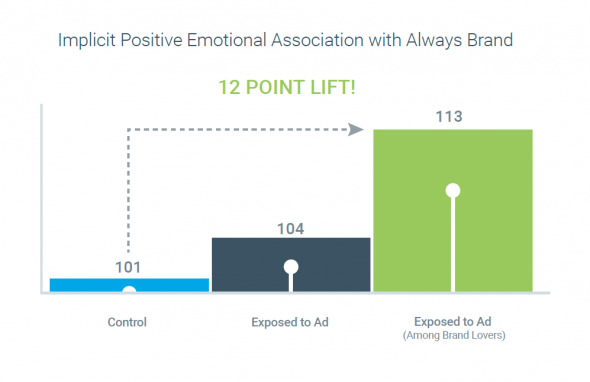Measuring the Subtext in Advertising: Emotion in Ad Testing
Persuasive advertising moves people with emotion.
At its essence, emotion is a relevance signaling mechanism. It tells us what we should attend to in our environments. It sets the magnitude of positive and negative affect associated with stimulus. It helps encode the associations between concepts in our memories. And it innately produces action tendencies.
These functions of emotion map perfectly to recent models of advertising effectiveness, which posit that successful ads take viewers through the sequential processes of attention, affect, memory and desirability. It is no surprise then, that market research on ad effectiveness, which has traditionally failed to adequately measure emotion in ad testing, has drawn the ire of the creative agency world for decades.

While Draper’s take on psychological research is fun to watch, it’s not just an example of Mad Men making something up for entertainment value. That sentiment is the subtext undergirding most research and creative interactions in our industry. Consider this quote from AdAge in their article naming Chrysler marketer of the year following their wildly successful “Born of Fire” ad (better known as the original Imported from Detroit Eminem ad).
“Mr. Anwyl said if the Chrysler 200 ad were analyzed by traditional measures, it would be faulted for not emphasizing the car it advertised.
Yet the spot was ‘magic’ and ‘knocked it out of the ballpark,’ he said.”
– Advertising Age
Or ask nearly anyone in the creative space how they feel about testing research; better yet, use an implicit measure to assess how they really feel! The good news for research on creative work is that we now have methods that accurately measure what matters in advertising: the function of emotion.¹
Best Practices in the Measurement of Emotion in Ad Testing
Measuring emotional response to an advertisement is not nearly as easy as asking people how they feel about an ad (for an example of this kind of measure, check out AdMeter).
Best practices call for both indirect and implicit measurement techniques. These techniques include eye-tracking, facial coding, neuro and biometrics and true implicit association techniques. Indirect measures are often better than direct measures and truly implicit measures avoid the “can’t say/won’t say” issue in market research.
In each section below we briefly describe the advanced methods for evaluating the constructs of advertising effectiveness, and provide a detailed case study on the use of implicit association techniques in ad testing.
Attention
Eye-tracking and visual saliency analyses provide deep insight on both “top-down” and “bottom up” attentional processes. Implementing eye-tracking within a controlled environment research lab produces precise moment-by-moment data on the elements that are capturing attention.
Importantly, from a practical and accessible point of view, these measures can now be reliably implemented in an online testing environment (albeit with less precision) making the incorporation of eye-tracking in ad testing globally scalable and efficient. Here is an example from a Sentient online Ad test:
Affect
Affect is typically measured as the combination of two constructs: valence and arousal. It can be measured indirectly and implicitly in numerous ways. Moment-by moment arousal is measured with great precision using biometrics (eg., heart-rate variability, skin conductance response, respiration), yet these measures inherently lack a valence marker for that arousal.
Facial coding is an indirect measure, which contains more noise, but does provide moment-by-moment valence. This technique is implemented online, making it an easily-scaled and efficient tool for gleaning insight on changes in affect across the course of an ad. When used in combination with other emotion measures, facial coding provides significant added value to an ad test.
Memory
The encoding of information can be captured reliably through the measurement of the strength of hippocampal activation during the processing of an ad (Venkatraman et al. 2014). However, reliably measuring activity in the Hippocampus requires an fMRI approach, and that labor-intensive method may not be required. If the intent of the research is to measure explicit memory of exposure to an ad, stated recall and recognition tests are sufficient.
Best practices in ad testing research not only require memory of exposure to an ad, but also implicit measures of the nature of what was encoded in memory due to exposure to the ad. Implicit association measures are the best approach for revealing the nature of what was encoded in memory.
Sentient Prime implicit associations measure change in the nature of associations with brands, products or services following exposure to an ad, and thereby represent a pure impact measure telling marketers whether their intended message is connecting at a preconscious level.
Desirability
All of the previous processes precede desirability, which is essentially the desired outcome of an ad. To effectively measure desirability, we need ad impact outcome variables, and these variables are better if they are not direct explicit questions on the desirability of a brand, product or service.
Among applied consumer neuroscience measures, implicit association techniques, offer the most practical, scalable and actionable ad impact insight. Best practices in the application of implicit associations to ad testing, require the use of true implicit techniques, measurement of change in emotional associations with the featured brand, product or service, and combining that data with derived preference data (as a measure of System 2 desirability).
Below is a case study of how to appropriately use Sentient Prime implicit associations within Ad Testing paradigms.
Implicit Association Measures as Impact Variables in Ad Testing
To illustrate best practices in implicit association applied to ad testing, we can learn from the R&D insights coming out of the Sentient Consumer Subconscious Research Lab.
A recent study evaluated the implicit impact of exposure to the 61 national 2015 Super Bowl ads on 3,107 consumers and tested the ability of implicit impact measures to add predictive accuracy above and beyond traditional ad evaluation measures (derived preference, AdMeter etc.). After exposure to a target ad and distractor ads in the pod, the randomly-assigned respondents completed a Sentient Prime implicit association test evaluating the emotional associations with the target brand and other key implicit self-relevance measures.
The implicit associations with target brands of those consumers exposed to the target ad were compared to those not exposed and a change score was calculated. Below is an example of one of the 61 ads tested. The Always #Likeagirl ad raised controversy online and won a Cannes Glass Lion award.
Exposure to this ad influenced the emotional associations with the Always brand. That is, the positive implicit associations with the Always brand were higher among consumers exposed to the ad, versus those that were not. Importantly, this effect was even more pronounced among those consumers who love the brand, resonating with their personal core values.

This advertising exposure “lift” was repeated for all 61 ads in the test. Not surprisingly, the Always ad generated significant social action online:
- Online Plays: 1,586,543
- Social Actions: 632,421
- Digital Share of Voice (SOV): 11.01%
Predicting Ad Success
This behavioral data (an outcome of exposure to the ad) is important to understand and be able to predict. Thus, in our evaluation of the ability for implicit association measures to add predictive accuracy to stated explicit measures, we used the online social actions as dependent variables in our models.
Using the amount of social behaviors observed for each ad as the dependent variable (source: iSpotTV, online views, social shares, and total digital share of voice), we first added a traditional conscious measure of ad evaluation to the predictive equation and observed the correlation for example, AdMeter rating (source: USA Today) correlated with the ad related behaviors (r=.33, p<.05).
Then we added the Sentient Prime implicit impact variable to the equation and observed significant lift in correlations with the ad related behaviors, R=.61, p<.05 (change in r-square, p<.05).
This study represents an effective use of implicit association measures as an impact variable in copy testing. The results are consistent with the ever-growing findings from the Sentient Consumer Subconscious Research Lab that true implicit measures add predictive accuracy to traditional conscious measures when trying to predict actual consumer behavior (from social actions to sales).
From Perverse Methods to Profound Insights
When used according to best practices, measurement of emotional response to advertising can more accurately predict ad success. These kinds of findings should serve to lessen the contention between creatives and researchers. Finally, we have methods that can more accurately measure the magic of brilliant creative. Perhaps these advancement will get fewer research reports tossed in the trash!
To learn more about how to incorporate emotional measurement in your ad testing, and truly capture the subtext of your ads, contact us at Sentient Decision Science or design your own implicit ad testing study at www.sentientprime.com.
[1] Note that functions produce emotions and emotion has function. The age-old market research distinction between “functional benefits” and “emotional benefits” is out-of-date with the current behavioral science based understanding of the role of emotion in choice.

This is an excellent summary of a complex subject. Have you found the holy grail to successful copy testing? I am going to read your white paper with great interest. Your perception of the communication process is very useful. The most difficult task is the measure of Affective responses to communicated messages, creative and often talent, which is too often ignored in copy testing. Facial coding as a measurement of Affect raises a lot of concerns the least of which is even Ekman recognized that full frontal observations (a la webcam) did not provide the range of emotional responses for coding emotions. He was fairly dismissive in later reporting of the seven emotions that are covered by basic frontal measures and are so ubiquitous in market research these days. Affectiva have done a lot on validating these seven emotions, but hand on heart at least three of them have vague .relevance to most advertising e.g. fear? Congratulations on this important work!!